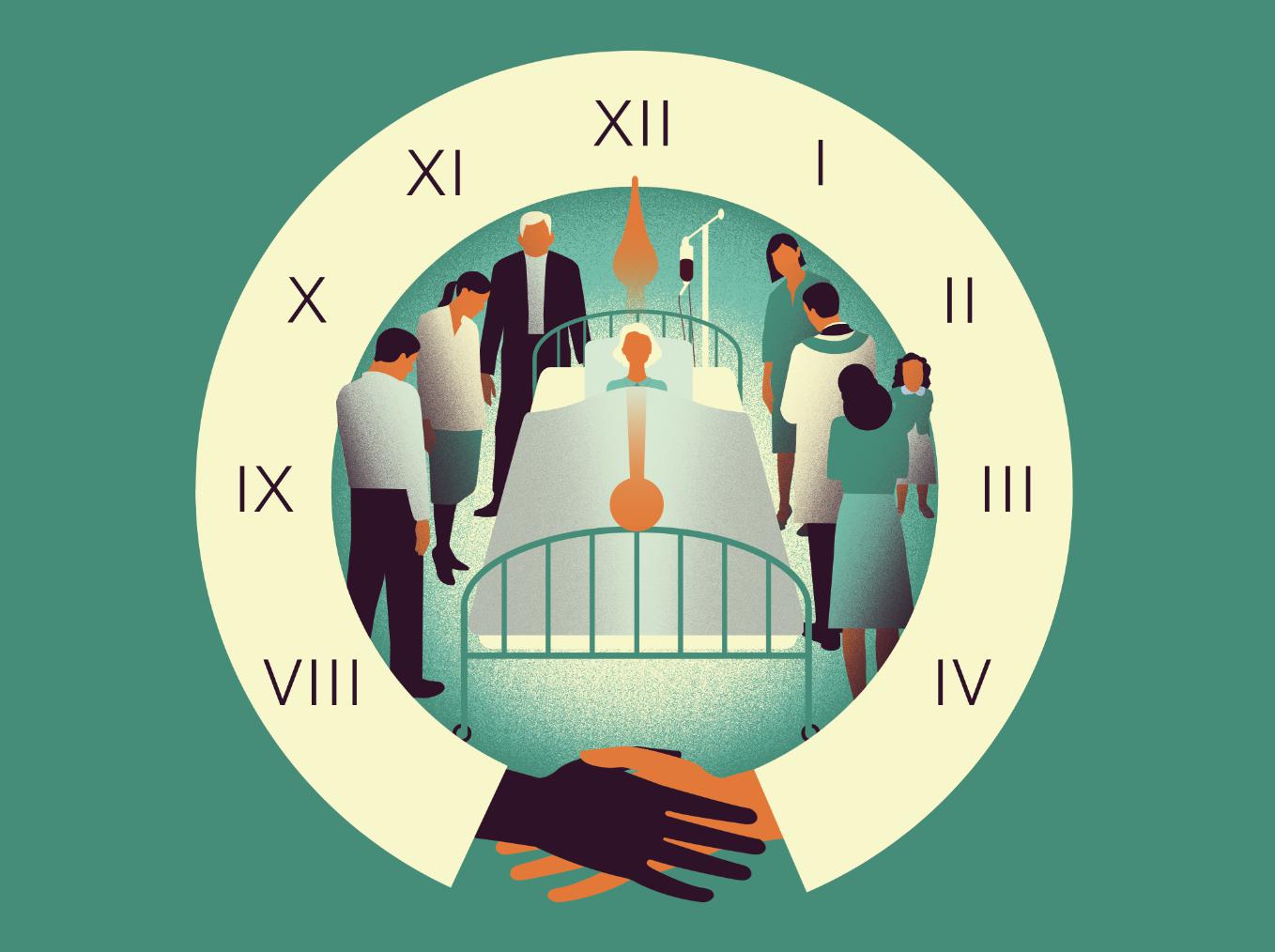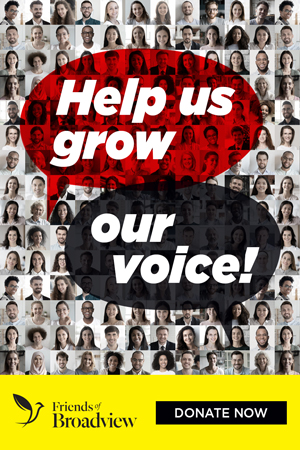“Eat your bread with joy.” That’s the message, a quote from Ecclesiastes 9:7, embroidered on the linen table runner Linda bequeathed to me. She knew of my joy of baking, and how it was often featured in my pastoral work. But even beyond that, the gift came to me with a special spiritual weight. Linda was an active member of my congregation and had a very aggressive form of cancer. We were sipping tea at her kitchen table in early December when she explained without fanfare how she had arranged for a dignified end through medical assistance in death (MAID).
We’d touched on the topic when I visited her in the hospital weeks before, though not in much detail. Now Linda had a date and a plan — in charge of her dying just as she had been of her living. Her death was 10 days away. “They’re not giving me much time,” she told me. “So, I have to get to it and pass along my gifts.” Many visitors in those days left with a present, something from Linda’s house to be given new life.
I’d spent the last two years working on a book about MAID, interviewing ministers and laypeople about their experiences and opinions. I was honoured by their willingness to share often-painful stories of loss, but I was speaking to them as a researcher. Linda was my first personal and pastoral contact with MAID.
Medically assisted death became a legal option in 2016 for Canadian adults “with a grievous and irremediable medical condition.” Since then, almost 7,000 Canadians have used it, at an average age of 72. More and more churches are experiencing congregants using MAID, creating new challenges and questions about pastoral care. How do you support someone through this journey, both while they’re discerning and if they choose a medically assisted death? What rituals can our church offer to help with this passage?
I confess that when Linda told me about her choice, I was caught off guard. As a pastor, I am more accustomed to lingering ends, walking the rough and uncertain emotional terrain that is the most common pathway toward death. In contrast, Linda’s life would end — and soon. What do you say? In the face of her certain death, I thought it would be too simplistic to give theological assurances of life beyond the grave. Offers of prayers felt too pious. So we sat in silence for a moment, keeping eye contact. I empathized about how hard the past weeks had been for her, drained by the roller-coaster ride of her disease and its treatment. I told her what was in my heart: that we at the church loved her and would miss her. I reminded her of how much energy and life she had given to our community, and how she made a real difference for so many.
More on Broadview: ‘A good death is being at peace with God, with others and with the self’
Linda was always joyful and open-hearted, and this was manifested in the days that followed. She and I didn’t discuss MAID very much at that point. It became a given, a backdrop. But in her frank way, she showed me what I heard so often in my research: “death is not the enemy.” The end was the end, and Linda leaned into it with purpose and joy. We laughed more than we cried as we talked over her life and final days.
Before MAID was an option, those diagnosed with cancer like Linda’s, ALS or other forms of degenerative disease lived on borrowed and very uncertain time. This meant that some of the best expressions of gratitude happened at the funeral when, for the person who had died, it was too late. Linda’s last days showed me that MAID can give us a form of eternity, a precious depth of time. With the focus that comes from knowing the exact time and place of death, we can say goodbye with meaning, complete the circle of our friendships, and close off our brokenness with forgiveness and grace.
Be that as it may, I realized that I had to do more work with my congregation. MAID is moving into the mainstream, and we had yet to integrate our many responses into a cohesive whole — an important step toward better supporting members who might grapple with this complex choice in the future.
Of course, MAID is not an easy decision to make, or an easy thing to talk about. The United Church took its first formal position on assisted dying in 2017, after receiving a report from the Theology and Inter-Church Inter-Faith Committee. “The issue of Medical Assistance in Dying is one that needs ongoing reflection and dialogue in communities of faith,” the authors concluded. “It may be chosen as a faithful option in certain circumstances. At the same time, there are many challenges that have emerged since this option became available, challenges both spiritual and practical.” To address these, the report stressed that “our communities of faith need to be safe places for discerning, thoughtful conversations about these options.…Those facing the end of their lives, and their families and friends, must feel that they will not be abandoned by the church at any point.”
Consequently, we held a day-long seminar at my church this past March on how MAID works, what to expect, and best practices around things like offering compassion, and how and when to alert the congregation to someone’s passing. It was a good way for our church to find common ground on issues of etiquette, confidentiality and care.
As a pastor, I am more accustomed to lingering ends, walking the rough and uncertain emotional terrain that is the most common pathway toward death.
We’ve now talked a lot about the policies and limitations around MAID, and what it could mean for people in our congregation and for ourselves. We’ve noted with considerable dismay that MAID as it currently stands does not address the nightmare of watching a loved one disappear into dementia; anyone who chooses MAID has to have the capacity to give consent a second time, right before the end. There is no option for advanced directives, so MAID can’t help someone who wants to end their life if they were to enter a vegetative state. Going forward, giving everyone clarity around exactly which conditions do and do not qualify for MAID will be an essential piece of our ongoing pastoral care.
We decided to contact the local palliative care service to ask for advice about how and when we should keep someone’s use of MAID confidential. We shared our discomfort with how to phrase our prayers for the care of someone who has or will die using MAID. We agreed that in the public’s mind, MAID is still too often associated with the same feelings we have about suicide, which colours our approach to it. We acknowledged that as we work out the tone and vocabulary of our compassion in this context, our response to MAID will be self-conscious, a bit stilted.
The procedure itself is not always the Zen-like peaceful ending we might imagine. I’ve been told there is some awkwardness in waiting, and that it can be surreal to have conversations with someone about to die.
Clergy have work to do to make sure we’re prepared to be present in these situations; to help counsel people wondering whether they might qualify for MAID; and to support people who have a real need, want to use MAID and yet do not legally qualify.
As an active pastor, one way to respond to this ongoing conversation is to host days of discernment. We should also enable our worship leaders with prayers and rituals crafted for those using MAID. If our goals are to bring healing and offer assurance at the end of life — and I think they should be — then clear minds about how MAID functions and open hearts that do not flinch at the prospect of someone choosing it will be required.
In that spirit of openness and clarity, Linda arranged for there to be a small circle at her bedside on her last day: her daughter, Shannon, some friends and a trusted retired pastor. A simple goodbye and she passed on. The linen she gave me now rests in my church office, a parting reminder of Linda’s wisdom to face her death with certainty. When I look at it, I’m reminded to focus on the bigger picture and not to wait until facing death to do the work of loving and forgiving — the best time to do it is now.
This story first appeared in Broadview’s November 2019 issue with the title “Final days.”
Broadview is an award-winning progressive Christian magazine, featuring stories about spirituality, justice and ethical living. For more of our content, subscribe to the magazine today.


Comments
Gary says:
As noted in the article, as a clergy, one can only respect the wishes of their congregants.
However, if asked for an opinion, I would note this topic is on the same level as abortion. Technically they're both murder. Sadly, atheists have sugar coated, and use emotion, to support the issues.
I'm intrigued, how humans can at one time support either topic (euthanasia and abortion) and yet feel accomplished when we save an infant at 21 weeks, or cure cancer for someone to live a fuller life. We don't make sense.
Jeanette says:
Where in the bible do you read that it is ok to MAID. God gives life and God takes it away. Sorry but I think it is not acceptable for a pastor to agree with this.
WG Nathaniel says:
Broadview keep up with this topic. This is now where Canadian policy is now at.
A Feb 2020 update on Canadian government policy (Reuters) - Canada's Liberal government proposed broadening a 2016 law on medically assisted death to include for the first time people who were not in immediate risk of dying. The proposed changes would "remove the requirement for a person's natural death to be reasonably foreseeable in order to be eligible for medical assistance in dying," Justice Minister David Lametti said in a statement.